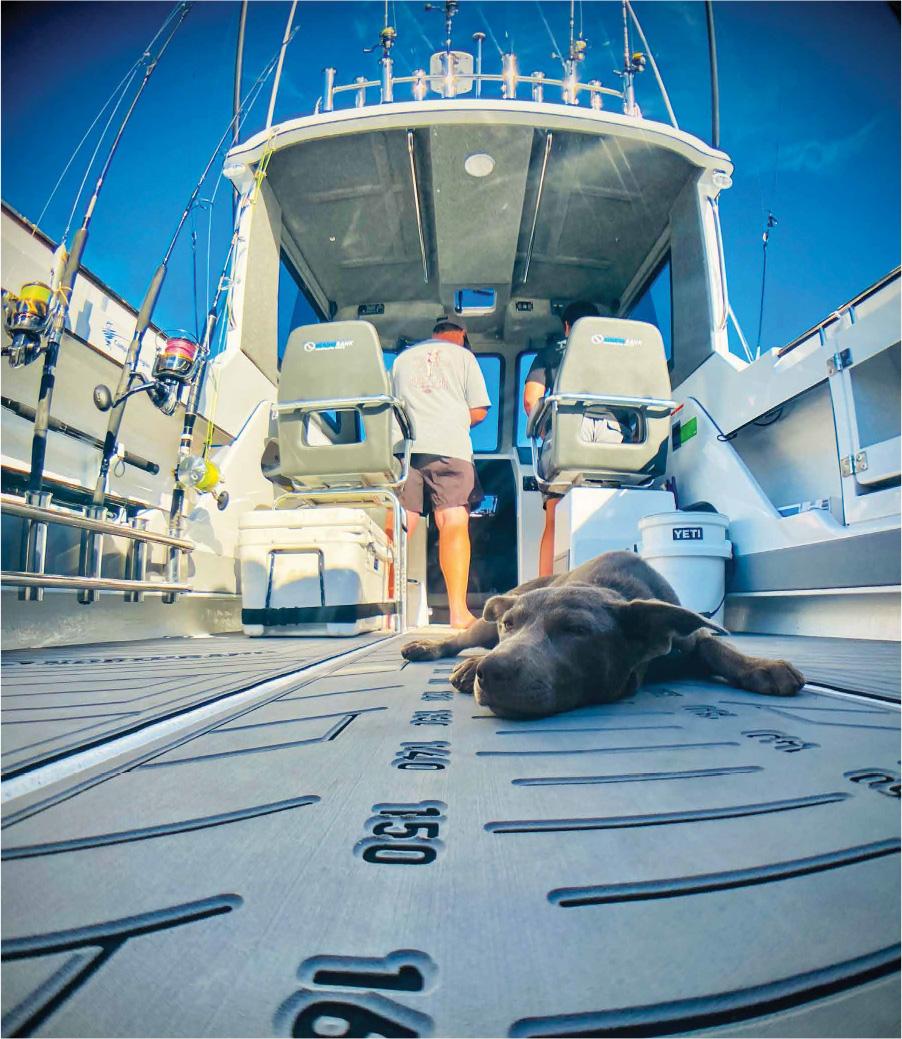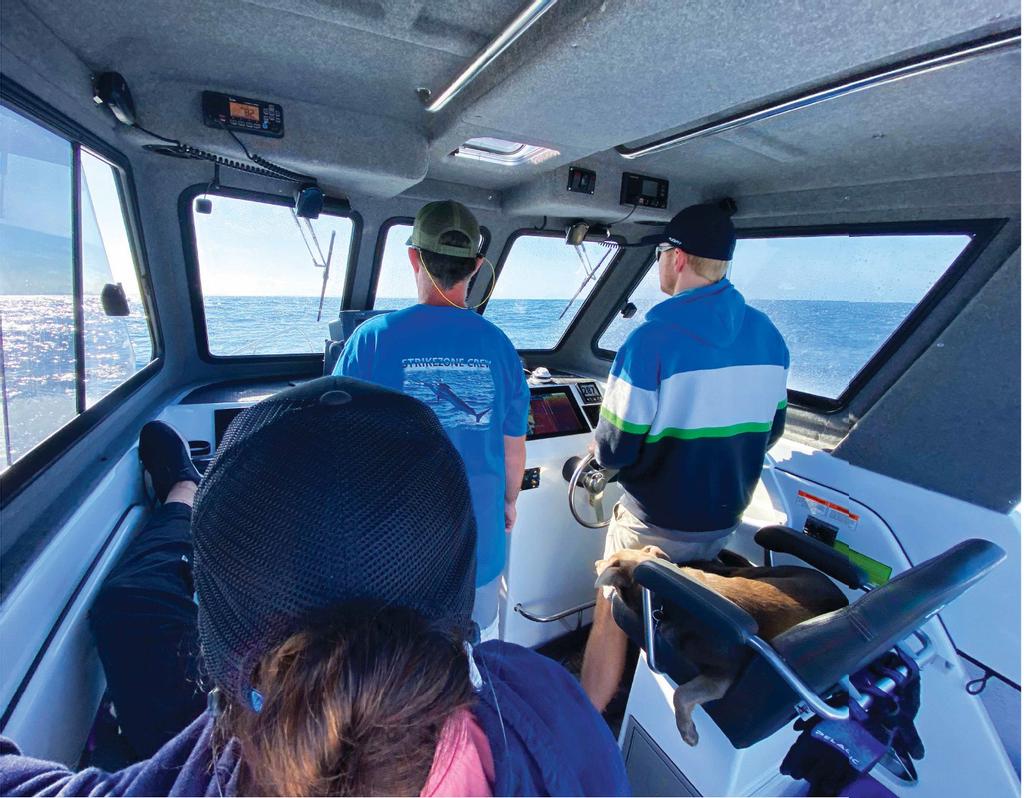These days, with less fish in the ocean, anglers need to travel and be nimble enough to go and chase the bite on a whim. Setting off as soon as the productive water conditions start forming up and the reports start flowing means you will catch more fish, so what you lose in size in a trailerboat you more than make up for in being able to chase the bite.
Fishing from a fully functional trailerboat was a no-brainer for me, but when I started looking into a new boat there were several factors I had to consider. Overall, I wanted the biggest working space I could fit into 6.5m. I couldn’t go any larger because towing then becomes too specialised which means you lose flexibility and become reluctant to chase the bite as required for consistent success.
Finally, after a lot of deliberation, I settled on a Northbank 650HT. Buying an Aussie-built product was important for me and while I have been let down by several Aussie builders in the past it quickly became obvious that the Northbank boats are in a class of their own. The key behind this is passion, and few designer/manufacturers are as passionate as Rob Cuming; he just loves building and constantly improving his boats. Made in South Australia, they are built tough to put up with some seriously daunting weather, making them the ideal vessel for my job.
ISSUES OF SIZE & PROTECTION
The biggest problem with trailerboats is effective working space. In a 40ft gameboat we can pack everything, but when you’re in a boat half that size you need to be a lot smarter about your management.
It doesn’t matter how we look at it, there is always the issue of space. However, the key is how we utilise what is available. Over the years, I have fished on just about every brand of trailerboat there is and although some have been great, others have been downright awkward and inefficient.
To further add to my requirements, I also have to contend with not just fishing gear but a truckload of camera gear, so I really do need the biggest 6.5m I can get. I also need everything to stay dry, especially when carrying more than $100,000 in camera gear. Obviously, centre-consoles were out, but even most of the cabin boats I have run will leak like a sieve in heavy weather. Vinyl clears are a joke because they all leak at the edges, but so do many hatches. Getting all my gear wet is no longer an option, and that’s another reason why I settled on the Northbank 650HT, as I can rely on it to stay dry and secure.

The 650HT is fully enclosed and the cabin space is maximised, reaching right to the sides. Now this means access to the bow is limited — something that made me sceptical initially — but in reality, the additional cabin space far outweighed having easy access to the bow. Staying dry and comfy keeps the morale of the crew high, and when you have the added pressure of filming weighing on your shoulders it’s worth its weight in gold.
We also found we could fish in more adverse conditions comfortably because we weren’t getting wet, and that meant more days on the water filming. I should point out that I did add a Lone Star anchor winch, which was a first for me, but an accessory that I found essential with limited bow access.
Within the first nine months I tallied 600 hours on the Mercury 250hp Verado outboard and have since made a series of modifications to the rig. Now bear in mind that these changes suit me and are specific to hardcore fishing and filming, so they may not apply to your situation. However, hopefully you can learn from what I have done to help make your own rig work better for you.
BUMP UP THE FUEL
For some reason, Aussie-built boats never seem to come with enough fuel capacity, with a comparable sized boat from the US often carrying as much as double the fuel. The Northbank 650HT comes with 300L, which is the biggest sized tank for its class, but even with the new incredibly economical 250 Merc on the bum, it’s still not enough for serious offshore fishing. As technology improves, we are traveling a lot further to sea in search of fish these days and that means we need much greater range. Sure, forwardthinking outboard manufacturers like Mercury are constantly pushing the boundary with ever-better fuel economy, but the fact remains we need to carry more fuel.
To achieve consistent success, the days of simply going to the edge of the continental shelf are long past. Now I regularly travel 40–50 nautical miles from the ramp just to reach the fishing grounds with what I have estimated (using online satellite charts) to be the water conditions most productive. On a big day I am chewing upwards of 270L of fuel, which from a standard tank doesn’t leave me with adequate reserve to come home — remember that a 300L tank doesn’t give you 300 useable litres of fuel. Your effective capacity will vary depending on where the pick-up is situated in the tank.
Initially I looked at building an extra fuel tank to fit into the centre hatch between the helm and passenger seat. This calculated out to give me roughly an additional 60L. However, the cost of custom building and fitting was upside of $1,000. That’s pretty expensive per litre, so instead I searched online and found a plastic tank which fitted perfectly, and was just a few hundred bucks. While it only carried 40 odd litres, the fact it is removable (and way cheaper) made it a much better option that still gave me enough reserve for those bigger runs.
To save further on the fuel tank upgrade I fitted it out myself, purchasing a three-way fuel tap, 3m of fuel line, 4m of breather hose and some hose clamps.
Another benefit of the Northbank is that the fuel tank is easily accessible under the centre part of the deck and, better still, removing it doesn’t mean dismantling the chairs. It really was relatively hassle-free after cutting the sealant and removing eight screws. The only drilling was a 50mm hole I had to cut through a single bulkhead, which allowed the hoses to lay perfectly across the main tank.
I mounted the tap on the port side of the bilge in-line with all the other hoses, keeping everything neat. I completed it all in half a day with the help of a few coffees. I decided not to flush-mount an additional fuel line for filling, and instead just fill it through the fuel, although I do need to be careful as spilt fuel means vapours will sit in the cabin. Not dangerous, just smelly.
I’m now looking into one of the excellent Turtle-Pac fuel bladders which are collapsible, removable, and much safer and tougher.
FISH-FINDING ELECTRONICS
One area that has changed dramatically for trailerboats is electronics. To maximise results, these days we need to invest in serious electronics, and my new Northbank was no exception — I have invested close to $65,000 in Furuno gear.
I run a Furuno 295 and TZ with four transducers from 1–2kW (including the new DFF3D system) which is effectively a basic sonar, giving me a much larger search area around the boat. For billfishing around bait schools, you simply can’t get any better because you increase your search area from below the boat to hundreds of metres around the vessel.

I also included a radar, but instead of the small dome version I bit the bullet with a solid state doppler radar. This is a big unit and is something I couldn’t run on previous boats because the hardtop simply wasn’t strong — yet another advantage of the Northbank 650HT. This addition wasn’t for safety, but instead it is specifically for finding clusters of birds concentrated over schools of baitfish or feeding tuna. The smaller dome radars simply don’t have enough power to spot birds, but this unit is amazing, and I am now regularly finding the bird patches. For offshore fishing, especially chasing tuna, this is a serious gamechanger for me. I should add that the height of the Northbank’s cabin roof helps the unit perform even better.
IMPROVED ACCESS TO THE BILGE
The downside to running such a big electronics package with four big transducers is that they clog up the bilge. This is made worse because the bilge area is quite compact on the Northbank. Adding further obstruction, the centre part of the deck, which covers the main fuel tank, overlaps the bilge by a further 200mm. This severely restricts access, and in the case of an emergency fix on a blocked bilge pump makes it near impossible.
Taking advantage of the centre deck being removed while installing the second fuel tank, I therefore trimmed down the deck to reduce the overhang to 60mm, just enough to conceal the fuel line connections. I finished it off by sealing a plastic lip so the water would deflect to the sides. Instantly this opened up the bilge substantially, giving much better access to the pumps, transducers, and the allimportant water-separator.
ALARMED WATER-SEPARATOR
While on the subject of water-separators, the one on my boat came without an alarm. Personally, I believe all boats should have an alarm wired directly into the water-separator. Contaminated fuel is one of the biggest issues with modern outboards, yet if the outboard’s alarm goes off, there is already water in the primary filter in the engine. I have suffered from dodgy fuel, and, believe me, trying to drain it on my Merc is virtually impossible. The filter sits tucked away at the back of the cowling and is incredibly difficult to remove especially with sausage fingers like mine — and this is while still on land, try doing it while rocking about at sea.
It should be standard practice to inspect your water-separator regularly, so having it easily visible and accessible is obvious, but it must also be alarmed. This precaution is all about prevention, as it’s essential that we stop the water getting into the engine in the first place. For that reason, I had the boys at Shannon’s Outboards install one immediately. Now, with the bilge opened up, I can check it and drain it easily at sea.
JUST THE BEGINNING
This is just the start of what I have done to customise and enhance the potential of my Northbank 650HT. We still have to go through the outrigger set-up, tuna tubes and livebait tank installation, plus the bait-rigging station and all the essential extras that make offshore fishing and filming more fun — but you’ll find out all about that in the next issue.
